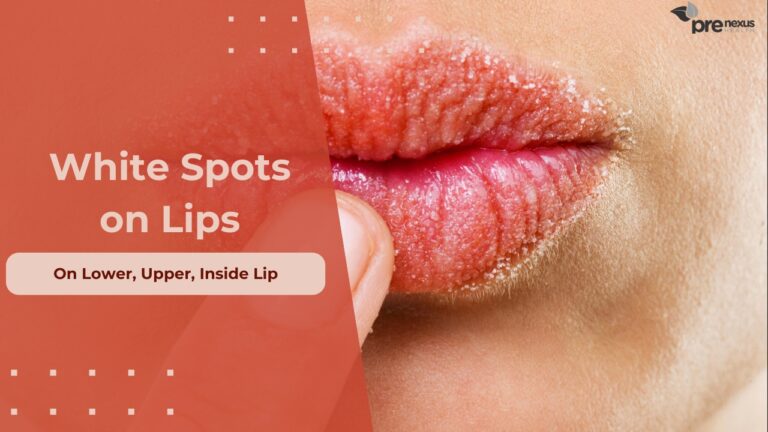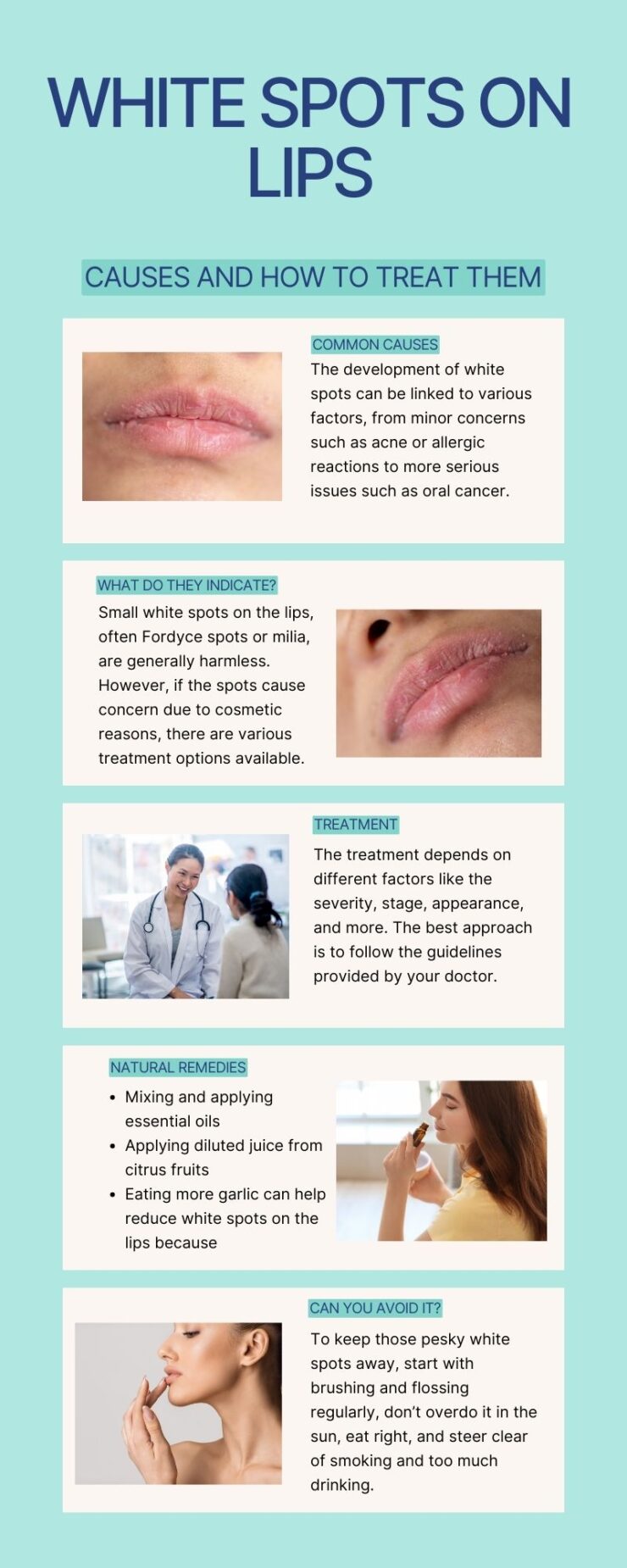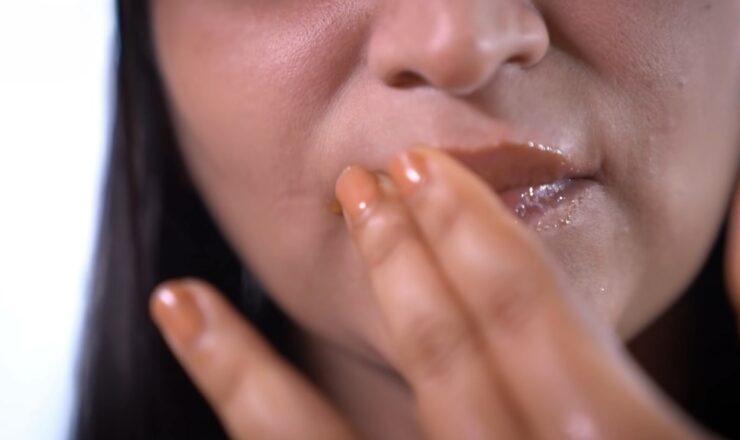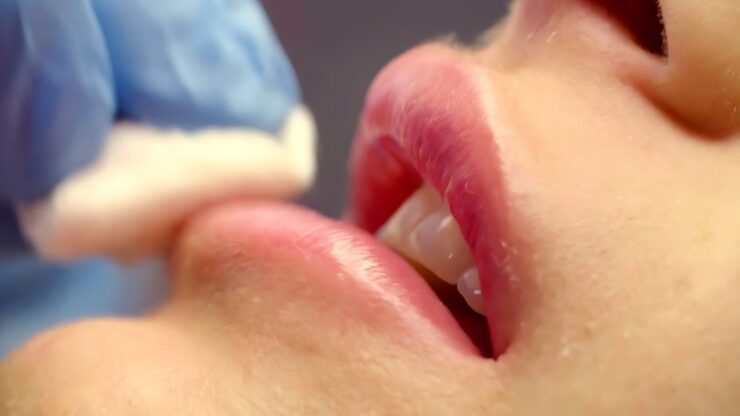Lips say a lot without speaking a word, but white spots on them can be worrying and knock our confidence.
These little spots might pop up on the top or bottom lip, or even inside the mouth.
It’s important to remember they could be telling us something about our health.
Knowing what’s behind these spots helps us figure out how to fix them and keep them from coming back.
In this post, we’re going to chat about what might cause these spots, how to deal with them, and when it’s time to get a doctor’s advice.
More About the Issue
White spots on your lips can be little dots, big patches, or even look like blisters. They might pop up on the bottom or top lip, or inside the mouth. Sometimes they’re smooth, other times they’re bumpy. To get to the bottom of what these spots mean, we need to take a closer look at why they happen.
Common Causes
The development of white spots can be linked to various factors, from minor concerns such as acne or allergic reactions to more serious issues such as oral cancer:
- Fordyce Spots: These are small, benign (non-cancerous) bumps that appear on the surface of the skin, typically on the lips or the inside of your cheeks. They are natural oil glands and are usually harmless.
- Oral Herpes: Caused by the Herpes Simplex Virus, this condition results in painful, fluid-filled blisters or sores around or on the lips or inside the mouth.
- Milia: These are tiny, benign cysts that occur when keratin, a protein in the skin, gets trapped underneath.
- Oral Thrush: This is a yeast infection caused by Candida fungus that can lead to white spots or patches in the mouth or lips.
- Oral Cancer: Although less common, white spots could indicate oral cancer, especially if accompanied by other symptoms such as pain, bleeding, or difficulty swallowing.
What Do They Indicate?
Small white spots on the lips, often Fordyce spots or milia, are generally harmless.
Fordyce spots are simply natural oil glands that appear as small white bumps.
Meanwhile, milia are tiny cysts caused by trapped keratin under the skin. In most cases, these spots require no treatment.
However, if the spots cause concern due to cosmetic reasons or discomfort, there are various treatment options available.
Treatment
As we’ve seen, white spots can have multiple causes, each requiring a different approach to treatment:
The treatment depends on different factors like the severity, stage, appearance, and more. The best approach is to follow the guidelines provided by your doctor.
Rachel Nall, a writer for HealthLine, describes different solutions depending on the exact cause:
-
Fordyce Spots: These are small, harmless bumps that don’t usually need treatment. If someone wants them removed for cosmetic reasons, options include electrosurgery or laser treatments to get rid of them.
-
Oral Herpes: This condition is managed with antiviral medications. These drugs can reduce the symptoms and frequency of outbreaks, but they don’t cure the virus itself.
-
Milia: These tiny white bumps can be professionally removed through extraction or treated with topical retinoid creams to help clear them away.
-
Oral Thrush: A fungal infection that results in white bumps, oral thrush is treated with antifungal medications. These can come in the form of a liquid solution that you swish around your mouth and then swallow.
-
Oral Cancer: The treatment for oral cancer may involve surgery to remove the cancerous lesion, chemotherapy, or radiation therapy, depending on the severity of the condition.
It’s important not to pick at these bumps to avoid irritation or infection. For some conditions, simple home care like rinsing with warm salt water can help reduce discomfort.
Natural Remedies
Chanchal Sengar shares a surprising list of remedies that can help, especially in the early stages. You can read more about it on OnlyMyhealth:
- Mixing and applying essential oils like olive oil and tea tree oil on the lips can help remove white spots.
- Applying diluted juice from citrus fruits like oranges or lemons to the lips can lighten white spots.
- Eating more garlic can help reduce white spots on the lips because of its antibacterial properties.
Can You Avoid It?
To keep those pesky white spots away, start with brushing and flossing regularly, don’t overdo it in the sun, eat right, and steer clear of smoking and too much drinking.
Advanced Treatment
If natural remedies or basic treatments fail, more advanced medical procedures may be necessary:
- Micro-punch Surgery: Particularly effective for Fordyce spots, this technique involves using a device to punch out individual lesions. It’s highly precise and carries a low risk of scarring.
- Cryotherapy: This treatment uses extreme cold to destroy abnormal or diseased tissue, making it a viable option for white spots caused by conditions such as leukoplakia.
- Electrodesiccation: Employed for conditions like Fordyce spots, milia, and certain forms of leukoplakia, this method uses an electric current to dehydrate the problematic tissue, leading to its removal.
- CO2 Laser Treatment: This is used to vaporize the tissue causing the white spots, and is often used for conditions like Fordyce spots and PPP.
Frequently Asked Questions
I’m a dermatologist who loves studying and treating skin (obviously). I went to medical school and chose dermatology because I wanted to help people with skin problems. I’m dedicated to helping people feel better about their skin (and in it).
Related Posts:
- Sunburned Lips - Blisters, Swollen, Treatment,…
- Red Spots on Legs: Causes, Small, Itchy, Non Itchy…
- Lump on Jaw Line - Hard, Movable, Painful Near Ear,…
- Rashes From Pads: Causes, Symptoms, Treatments, How…
- Underarm Pain Causes – Left, Right, Breast, & Sharp…
- Rash Under Breast: Causes, Symptoms, Treatments, How…







